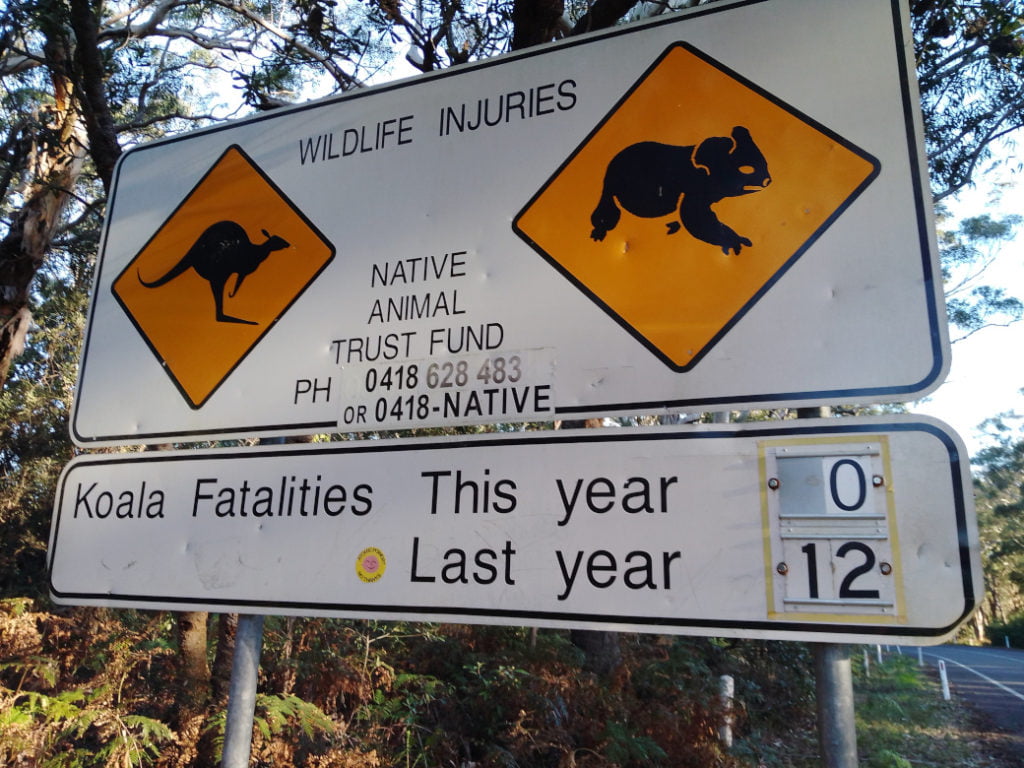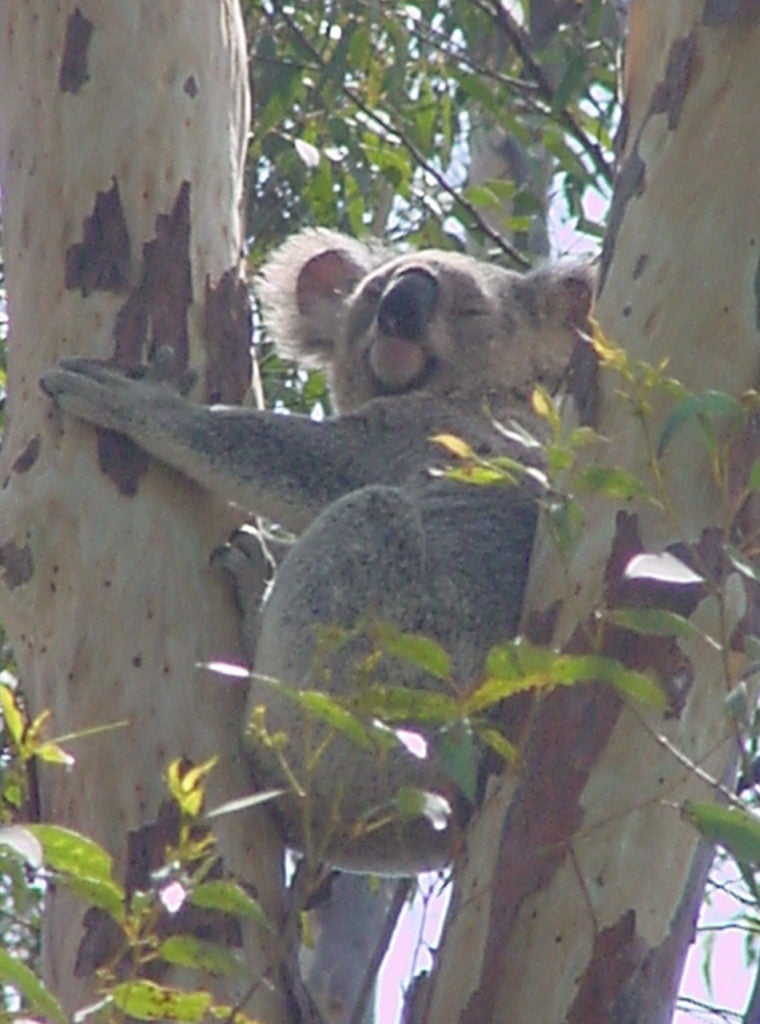
Have you seen this sign? Sounds like good news, or is it?
You would think that fewer koala deaths is a good thing, but these numbers reflect more than meets the eye. Encounters with koalas by the local community are more rare these days and although we don’t know for certain how many koalas are out there, fewer deaths means likely fewer healthy animals left in the wild.
It’s evident that people and koalas are competing more than ever for prime coastal real estate. Prior to the Black Summer bush fires 2019-2020, koala carers and wildlife hospitals on the NSW mid-north coast used to report higher mortality figures and those admitted for treatment than they they do now. Dr Darryl Jones states that this is “principally because the numbers of local koalas have declined significantly.” The same pattern has been emerging in Port Stephens and adjacent LGAs despite not having experienced the horror of the bushfires.

Koala Koalition EcoNetwork Port Stephens (KKEPS)
KKEPS was formed in June 2021 in response to the growing need for a strong voice to advocate for better protection for koalas in Port Stephens and neighbouring LGAs. It operates as a Special Interest Group within EcoNetwork Port Stephens.
The members of this alliance, comprising groups and individuals, are committed to working collaboratively with local councils, landholders, environment groups and other stakeholders to ensure that strategies such as the Comprehensive Koala Plan of Management (CKPoM) are actively used to address and rectify the plight of koalas in our region.
Similar groups exist in other parts of NSW and Australia where advocacy and on ground actions, such as protection of habitat and corridors through private properties, have had great success.

Protect the Unburnt
During the Black Summer bushfires, it is estimated that around 30,000 koalas perished and millions of hectares of habitat were destroyed. Experts advised that there should be a moratorium on further land clearing in crucial koala habitat across Australia but this has fallen on deaf ears in NSW. The Port Stephens community was devastated when the expansion of the Brandy Hill quarry was given the go-ahead in October 2020 by the Federal Environment Minister. Surely governments at all levels have an obligation to provide better protection for koalas? The situation is all the more critical since koalas sadly became a bushfire impacted species in 2020.
Members of KKEPS believe that koalas in at least some parts of Port Stephens should be listed as critically endangered for the following reasons:
- A mosaic of local extinctions is already occurring.
- Raymond Terrace is just one of the locations with no sightings reported in several years.
- Medowie and Williamtown sightings have become increasingly rare as forests continue to be destroyed for housing and industrial expansion.
- Bushfires burn through more frequently
- There appears to be no local or state planning policies with regard to legislating wildlife corridors.
- We also understand that a recent DNA study of koalas in Port Stephens shows a reduction in genetic diversity due to habitat fragmentation.
- Fewer local rescues suggest a reduction in the wild population, as do fewer deaths as stated in the opening above.

In NSW, there has been as much as a 60% increase in habitat destruction and fragmentation since the State relaxed its native vegetation laws in 2017. A further 24% of all modelled koala habitat was impacted by the Black Summer bushfires of 2019-2020.
In July 2021, representatives from KKEPS prepared a detailed submission for the draft conservation advice and Commonwealth listing assessment. In view of the above concerns, KKEPS supports, and is strongly advocating for, the ‘eligibility of Phascolarctos cinereus (Koala) for inclusion on the EPBC Act threatened species list in the Endangered category; and 2) the necessary conservation actions for the above species.’
Many of the key points will be included in another important response that KKEPS is working on: responses to the Draft National Recovery Plan for the Koala under the Environment Protection and Biodiversity Conservation Act 1999 (EPBC Act). As stated on the Department’s webpage ‘the public consultation process gives Australians the chance to have their say on the draft plan that sets out the research and management actions necessary to stop the decline, and support the recovery, of the nation’s threatened koalas.’
Wildlife Corridors

Ecologists will tell you that fragmentation and encroachment into large or small pockets of habitat will inevitably lead to local population crashes, contributing to state and even nationwide koala extinctions. We cannot keep allowing one tree at a time to be removed without accepting that one day soon, there will be no koalas left in NSW. Without urgent intervention, the NSW Koala Inquiry estimated that this could happen by 2050.
As the concept of wildlife corridors is not adequately taken into account by local or state planning authorities, remaining koala hubs are becoming isolated islands dissected by major roads and new housing estates.Wildlife corridors need to be kept as intact as possible through private land that links fragmented pockets of koala habitat. Every landowner, whether on acreage or smaller blocks, can do their part to ensure that not only feed trees are retained but also other trees that koalas can use to traverse from one hub to another.

In June 2021, ABC Landline’s ‘Bushfire Recovery Special featured an inspiring project in northern NSW. Host, Pip Courtney says: “Landholders and volunteers are planting thousands of trees to create hundreds of kilometres of corridors to try and halt the alarming decline in koala numbers.”
Former tennis player Pat Rafter, is one of the landowners committed to this local project planting thousands of koala trees on his property to connect koala hubs. Creating wildlife corridors is one of the more achievable outcomes that a community can undertake through a collaborative project as the Bangalow Koala group has shown us. It is estimated that many of the habitat and feed trees will provide a canopy in as little as five years.
We hope that the Port Stephens community will be inspired to collaborate on a similar project in our area.
Koala-corridors: planting a tree highway for koalas (Season 30, Episode 20).
If you missed this inspiring Landline Bushfire Recovery Special, you can view it here.
Useful links:
